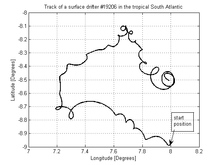Inertial vibration
The inertial vibration , even Inertialschwingung called, is a characteristic transient form of movement of the water in an unlimited ocean on the rotating earth , through the balance of the inertia force and the Coriolis force is determined. The inertial oscillation is the special case of the Poincaré wave with an infinitely long wavelength .
Since Gustafson and Otterstedt first observed inertial vibrations in the Baltic Sea in 1932 , they have been detected in almost all oceans and marginal seas .
properties

In the near-surface layer of the ocean (z> -h), the resulting velocity vector rotates, starting abruptly with t = 0, with a constant amount, clockwise in the northern hemisphere and counterclockwise in the southern hemisphere, with the following circular frequency , which is also called the Coriolis parameter:
It is
- the angular velocity of the earth's rotation
- the latitude
- T i the inertia period ( period of the inertia vibration):
The water particles in the near-surface layer move in circles with the radius
The characteristic speeds in large parts of the ocean are of the order of magnitude
In the middle latitudes the Coriolis parameter has the order of magnitude
In contrast, the Coriolis parameter is one order of magnitude smaller in tropical latitudes , so the radius of gyration there is 10 km.
The deep ocean below z ← H remains at rest, as the surface current is free from divergences and therefore no horizontal pressure gradients are built up that could set the deep layers in motion.
Mathematical description
Here, let us consider a simple example: the water in the upper layer of the ocean, at time t = 0 on the velocity u 0 speeds, namely uniformly from the surface z = 0 up to the depth z = -h by a sudden impulse on a large scale, d. H. spatially constant, to the east. Large-scale means that the stimulating momentum must be constant over an area with a diameter much more than a Rossby radius .
The equations of motion for the water particles are then, neglecting the friction :
With
- u, v are the components of speed to the east and north
- the twist angle
- δ (t) is the Dirac delta function .
The components of the speed then have the following course:
Observations and occurrences
If inertial vibrations are excited in limited seas, divergent currents inevitably arise on the coasts, since the currents here cannot be directed perpendicular to the coast. The resulting pressure gradients stimulate, among other things, a barotropic Poincaré wave that radiates from the coast into the ocean. A current develops behind the wave front which modifies the water movements associated with the inertial oscillations in such a way that the water transport of the entire water column perpendicular to the bank is zero. The deep ocean is set in motion by the Poincaré wave.
The front of the barotropic Poincaré wave spreads from the coast into the ocean with the speed that even in the Pacific the wave front reaches the opposite bank in the order of a day. In practice, a pure inertial oscillation in the surface layer on earth can only exist for a maximum of one period of inertia. After that, the deep ocean is also set in a movement opposite to the surface layer. The movement in the deep layer is generally very weak in the ocean, since its amplitude is related to the amplitude of the cover layer as if H is the water depth of the ocean.
See also
literature
- T. Gustafson, B. Otterstedt: Observations de courants dans la Baltique 1931 . Svenska Hydrografisk-Biologiska Commissionens Skrifter, Series Hydrographi XIII. 1932. pp. 3-14














